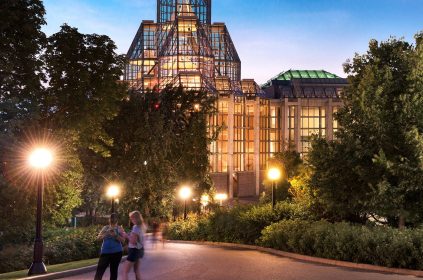What elements in a building can inspire wellness? For architect Robyn Whitwham, it’s large windows, good ventilation and colourful walls that make a space come alive.
These elements and more have inspired Whitwham as she designed the new hub for Stella’s Place, a fast-growing mental health centre serving young people, free of charge, in downtown Toronto.
The design journey has been a personal one for Whitwham, a 29-year-old Stantec architect, who falls into the same age category, 16-29, as the youth that Stella’s Place helps every day. The impact Stella’s Place has had on people her age, Whitwham said, was top of mind as she drafted sketches for what its new space in a former candy factory in Alexandra Park would look like.
“Everyone has a connection to them because everyone suffers from mental health challenges in some way, shape or form,” Whitwham said. “A place like that in the community has likely helped a lot of my peers.”
Stella’s Place has been operating in Toronto since 2013, and serves about 500 youth and their families annually. It’s described as a one-stop shop for young people who need mental health support: it offers counselling sessions, access to a psychiatrist, peer mentors and employment resources.
But the centre quickly gained popularity and outgrew its current space, where services have been provided since 2016, said peer support worker Asante Haughton.
“It’s tight,” Haughton said of the current space. “It’s gotten to the point where you physically can’t have all of the staff working at the same time.”
Operating in a small space has not only had an impact on daily operations, but Haughton added it has also made the waitlist for youth seeking services a lot longer than it should be.
“It’s been growing,” Haughton said. “Our founding goal was to have a waitlist that is far shorter than any other mental health service out there.”
Haughton said the uptick of demand is tied to a number of reasons; one being an increase in awareness of mental health issues. Another reason is Stella’s Place’s unique model of serving people up through age 29, while many youth services in the city cut people off at age 24 or 25.
“We understand that when a young person goes through mental health challenges, it interrupts the regular flow of (their education),” Haughton said, and therefore interrupting their ability to find stability and access to services that can otherwise be costly.
Community is also a big factor in how Stella’s Place operates, Haughton said — it tries to offer more than just services, but also a place to form friendships and connections with people of the same age who are experiencing similar struggles.
That’s why the centre’s cafe, where youth could drop in for services prior to COVID-19 social-distancing restrictions, has been so integral to its operations — and why expanding it was part of the guiding vision for the centre’s new building.
With this in mind, Whitwham said she hoped to design a space that was both fun and creative, as well as one that was safe and comfortable. “It was about finding the balance of creating an environment that’s non-clinical, but at the same time safe and effective for what their needs are,” she said.
There’s also a balance sought between open space and the need for privacy for youth experiencing distress. In addition, the space incorporated much of the feedback that was given by clients — Whitwham held consultations with them and staff to determine what they wanted the new building to look like.
“What we heard from them a lot is, ‘We want it to feel creative, we want it to be colourful, we want it to energize you,’” Whitwham said.
Haughton said this resulted in a modern, open-concept approach with bright colours sprinkled throughout. The space’s hanging stairs are made of glass, creating a sense of transparency and connection with everyone else in the room. The youth also ensured the space would be accessible for everyone accessing the space, Whitwham added, and emphasized the need for an elevator that serves all floors.
Whitwham said the youth were also fond of the building’s unique history as a former candy factory that was built in 1926. It is why she tried to incorporate much of the original building elements in her design, like keeping its bright brick exposed and the original large windows as an homage of a bygone era of Toronto architecture.
Stella’s Place has budgeted $13 million for the new space on 54 Wolseley Street. Founder Donna Green said the centre launched a fundraising campaign to fund the project, and has so far raised 80 per cent of what’s needed.
Whitwham said construction began early this month. When it’s ready (slated for late 2021), Whitwham said she hopes the space evolves with the needs of its users and that youth will not be afraid to make it their own.
“In the next five years, my hope is that people that are using this building feel a personal connection with it, and feel that they had a hand in helping shape it and design it,” Whitwham said.
For Haughton and others at Stella’s Place, the new building signifies the next chapter in the centre’s journey. What was once a small community organization, Haughton said, is now on its way to expanding its reach.
“The vision has always been for Stella’s Place to be able to serve as many young people across our city as possible,” Haughton said.
“In a lot of ways, we are setting a tone for what mental health service can look like.”
Nadine Yousif, Local Journalism Initiative Reporter, Toronto Star













